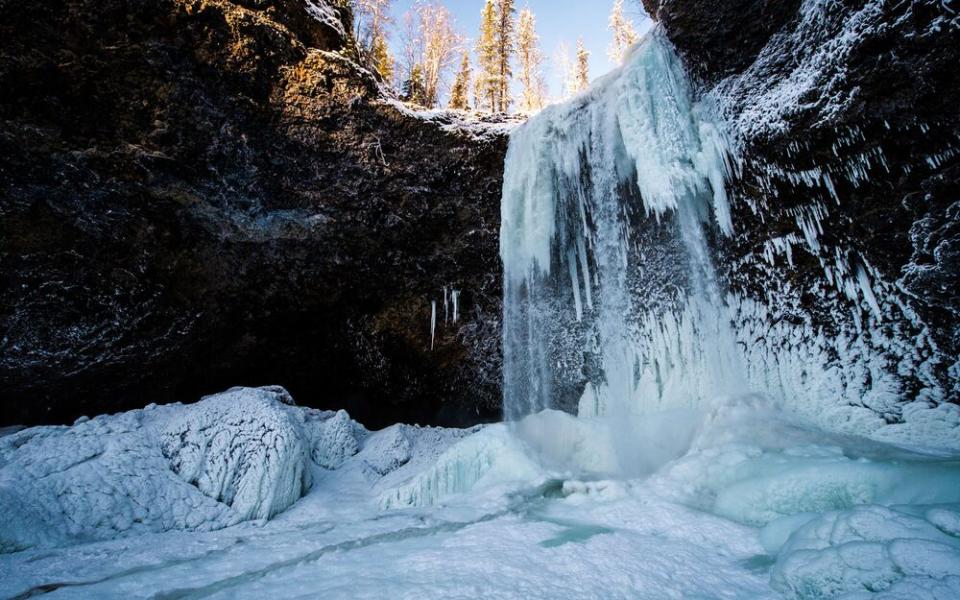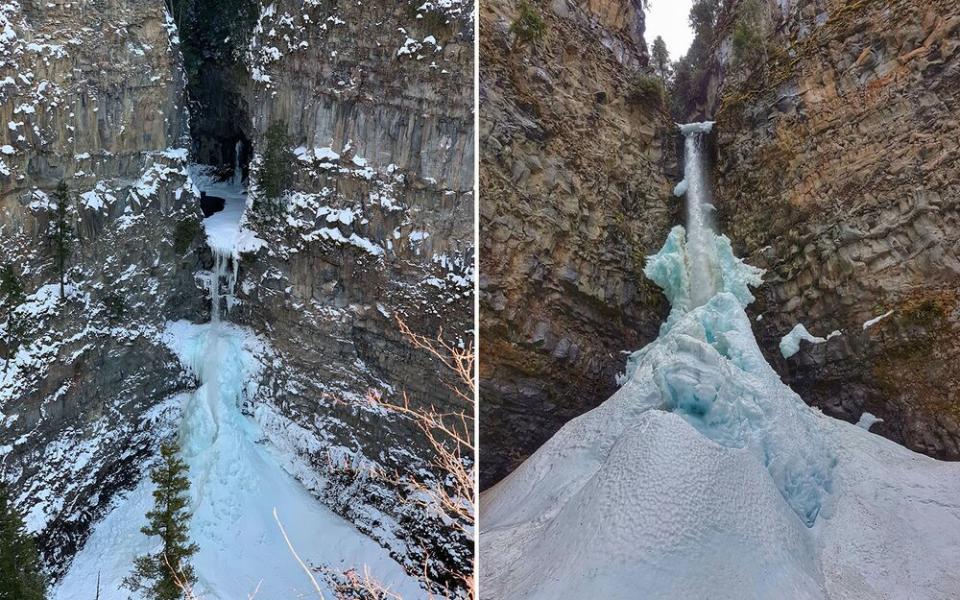You Definitely Should Go Chasing These Magnificent Frozen Waterfalls in Canada
You can hear it before you can see it. It’s winter in Wells Gray Provincial Park, a 1.3 million-acre paradise of inland rainforest, volcanic fields, and mountains in British Columbia, Canada. Covered in thick snow, everything around me is hushed with the silence that winter brings, except for the sound of a distant roar. I follow my ears, the roar growing louder and louder, until I come upon a soaring waterfall. Covered in white, it’s mostly frozen, but has water still flowing through, creating a sound now loud as thunder.
The waterfall is just one of 41 named waterfalls in Wells Gray, with more being discovered all the time. In fact, Wells Gray Provincial Park is known as the land of waterfalls, and while these grand falls are spectacular as they flow full speed during the warmer months, discovering them during winter brings sparkling ice and snow formations. Plus, winter means less crowds for peak enjoyment. For a winter experience you’ll never forget, it’s time to go against TLC’s advice and chase some (frozen) waterfalls.
Here are five in Wells Gray that you can’t miss.
Helmcken Falls

Dropping almost 500 feet below into a canyon, Helmcken Falls is the fourth largest waterfall in Canada. In winter, a frozen cone of water glimmers at the base, shooting 164 feet up from the canyon. Marvel as water spews over the edge, yet seems to form instant powder as it crashes into the bottom of the canyon. Helmcken is accessed just steps from the road, and the viewing platform here, cleared all season long, provides a panoramic view of this winter wonderland. For a closer view, hike or snowshoe on the Helmcken Falls South Rim Trail, a three-hour trip that provides stunning views. Use caution, as parts of the trail are close to the canyon’s edge.
Dawson Falls
Gurgling down the Murtle River, Dawson Falls isn’t nearly as tall as Helmcken, but is often referred to as a smaller version of Niagara Falls. Dawson Falls pours 295 feet across 200,000-year-old lava beds to create a shallow, broad flow of water. To get here, park on Clearwater Valley Road and walk down the trails. The surrounding forest quiets everything but the rushing water. You can continue along the trail to see the view from the top of the falls.
Moul Falls

In the warmer months, it’s possible to get behind the veil of water at Moul Falls, but not so much in the winter as the water freezes. But that doesn’t mean you should skip this waterfall when the temperatures move below freezing. The jaw-dropping Moul Falls is a bit more challenging to access than other waterfalls in the park, as this trail is not maintained in the winter, and the last portion has a steep descent with possible slippery sections, steep cliffs, and falling ice. Extreme caution is advised. The almost 2-mile hike or snowshoe goes along the flat trail to Moul Falls, and the trail to the base offers views of the icy water veil next to the lava rock cave.
Spahats Creek Falls

Formed by volcanic rock deposits centuries ago, the canyon at Spahats Creek has layers upon layers of rock, all made more dramatic from the white snow. The waterfall spits out from a keyhole in the rock face, 260 feet above the Clearwater River. With a relatively slow flow, the frozen water creates blue ice forms as it builds at the base. Trek through hemlock and cedar forests for about five minutes, and you’ll see (and hear) the falls just inside the park gate. This fall also has a viewing platform.
Mushbowl Falls
Crossing the one-lane wooden bridge on the way to Helmcken Falls, you’ll spot Mushbowl Falls. Mushbowl forms as the Murtle River splits in two, with frozen water features glistening around rock formations near the bridge. The surrounding forest creates the perfect winter postcard photo. Access is easy. After crossing the bridge, you can pull over and check out the falls from a safe distance.
